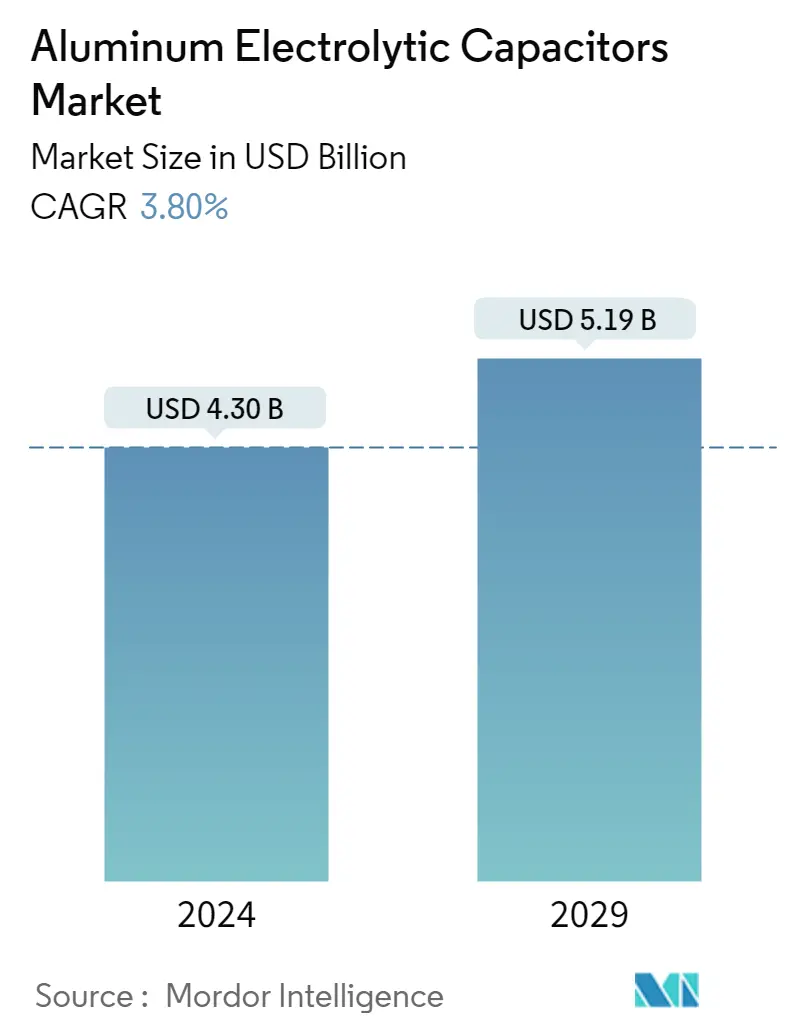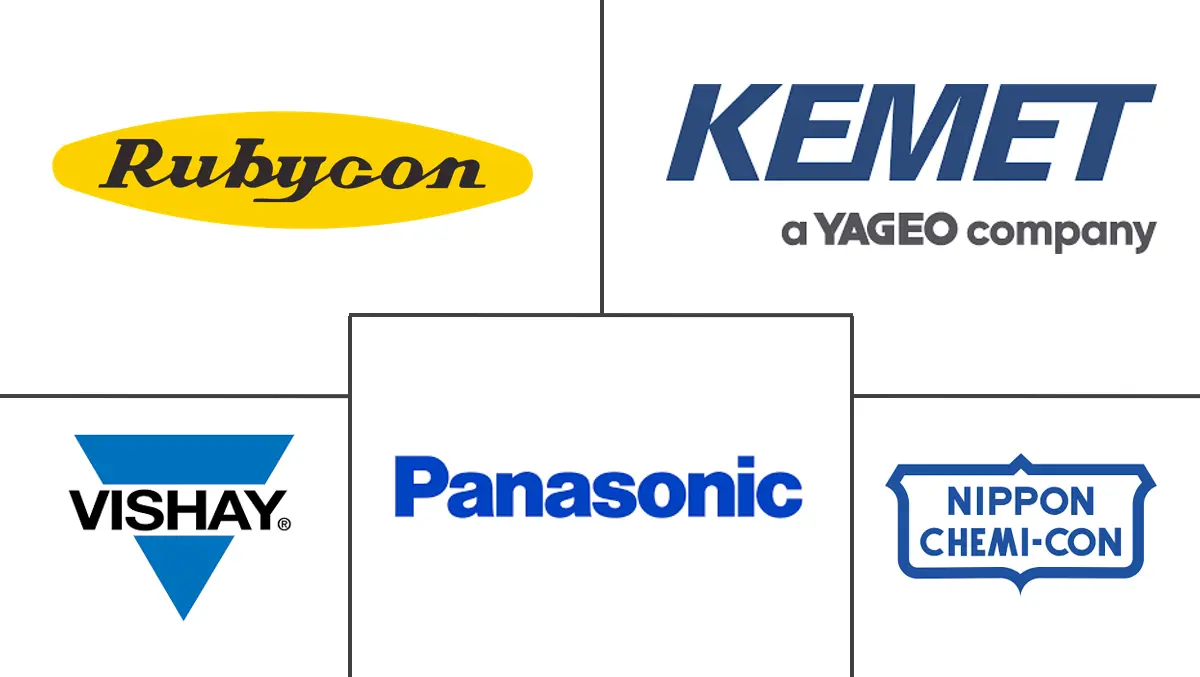Market Size of Aluminum Electrolytic Capacitors Industry

| Study Period | 2019 - 2029 |
| Market Size (2024) | USD 4.30 Billion |
| Market Size (2029) | USD 5.19 Billion |
| CAGR (2024 - 2029) | 3.80 % |
| Fastest Growing Market | Asia Pacific |
| Largest Market | Asia Pacific |
Major Players
*Disclaimer: Major Players sorted in no particular order |
Need a report that reflects how COVID-19 has impacted this market and its growth?
Aluminum Electrolytic Capacitors Market Analysis
The Aluminum Electrolytic Capacitors Market size is estimated at USD 4.30 billion in 2024, and is expected to reach USD 5.19 billion by 2029, growing at a CAGR of 3.80% during the forecast period (2024-2029).
- Aluminum Electrolytic capacitors have gained a reputation for being extremely reliable and stable passive components. They are extensively utilized in different sectors, such as commercial, industrial, and automotive, mainly due to their remarkable ability to withstand extreme temperatures. These capacitors are highly effective within a broad temperature range and can endure temperatures as high as 250°C. Moreover, they demonstrate outstanding stability and insulation resistance. In terms of leakage current-temperature characteristics, electrolytic capacitors outperform numerous other high-temperature capacitors currently available in the market.
- Aluminum electrolytic capacitors exist in multiple applications, such as power supplies and computer motherboards. These capacitors are mainly used when large capacitance is required, and leakage current is not essential. These capacitors are available in different sizes and shapes, primarily depending on properties such as working voltage, type of electrolyte, and applications.
- Various factors, such as the plate area and the thickness of the electrolyte, primarily determine the capacity of an aluminum electrolytic capacitor. This also means that a capacitor required for large capacitance can be bulky and more prominent in size.
- Moreover, according to HuanYu Future Technologies, the reliability selection of military electrolytic capacitors is directed toward tantalum capacitors and aluminum electrolytic capacitors. One of the significant advantages of aluminum electrolytic capacitors is their availability, as aluminum is widely distributed in China and is made available at lower prices for large production. In addition, the metal is preferred for electrolytic capacitors due to its characteristics, such as its lightweight and self-healing properties.
- However, the non-gas sealing element with the aluminum shell is generally used, which makes it unreliable. Also, its adaptation to the environment temperature range is considered narrow, especially regarding negative temperature characteristics, generally -20°C (individual military products can reach -40°C, and the military STANDARD CDK series is -55°C). Therefore, aluminum electrolytic capacitors are mostly suitable for general civilian electronic products with low environmental requirements. Some of the capacitors are also used in ground military electronic whole machines, which also require low reliability requirements.
- Additionally, it is mentioning that vendors in the market are broadening their product range by introducing new aluminum electrolytic capacitors. For instance, In 2023, Kypcera AVX, which features a radial-leaded selection consisting of the REH, REF, and REH Series wet aluminum electrolytic capacitors, the RPA and RPF Series conductive polymer aluminum electrolytic capacitors, and the RHA and RHD Series hybrid aluminum electrolytic capacitors. This expanded range offers a diverse array of part numbers, catering to both commercial and industrial reliability requirements, all while maintaining a competitive pricing structure.
- During the pandemic, new projects around the world were put on hold, which decreased the demand for analog semiconductors. However, in the post-pandemic situation, global factories that faced challenges during the pandemic are now gaining an advantage by incorporating new aluminum electrolytic capacitors. Furthermore, recovering economies and industries from the pandemic have triggered the revival of manufacturing activities across various sectors, thereby boosting the demand for the market under study.
- Although aluminum electrolytic capacitors have many benefits, they are hindered by certain limitations such as a short lifespan, equivalent series resistance, less value tolerance, and significant leakage currents. These factors prevent their widespread use in various industries, which is affecting the sales of aluminum electrolytic capacitors. Additionally, the increasing preference of customers for multilayered ceramic capacitors (MLCCs) in new cellphones, entertainment systems, and other computing solutions is reducing the demand for electrolytic capacitors.
Aluminum Electrolytic Capacitors Industry Segmentation
Aluminum electrolytic capacitors can be used in decoupling and power supply applications. They store the bulk of their charge on two aluminum metal foil layers that act as electrodes, separated by an insulating spacer paper, and wound together with a carbon material to give them an electrolytic capacitor. The main difference between aluminum capacitors and other types of capacitors is that the former can store a lot more energy than any other type of capacitor due to its large electrode area.
The aluminum electrolytic capacitors market is segmented by voltage (high voltage and low voltage), applications (industrial, telecommunications, consumer electronics, automotive, energy & power, and other applications), and geography (North America, Europe, Asia-pacific, Latin America, and Middle East and Africa). The market sizes and forecasts are provided in terms of value (USD) for all the above segments.
| Voltage | |
| High Voltage | |
| Low Voltage |
| Applications | |
| Industrial | |
| Telecommunications | |
| Consumer Electronics | |
| Automotive | |
| Energy & Power | |
| Other Applications |
| Geography | |
| North America | |
| Europe | |
| Asia-Pacific | |
| Latin America | |
| Middle East and Africa |
Aluminum Electrolytic Capacitors Market Size Summary
The Aluminum Electrolytic Capacitors Market is projected to experience substantial growth in the coming years. The market's expansion is fueled by the capacitors' reliability, stability, and their ability to withstand extreme temperatures, making them ideal for various sectors such as commercial, industrial, and automotive. Additionally, their wide application in power supplies and computer motherboards and their availability in different sizes and shapes depending on working voltage, electrolyte type, and applications contribute to their market demand. Despite the challenges posed by the pandemic, the Aluminum Electrolytic Capacitors Market is recovering, with vendors broadening their product range and global factories incorporating new aluminum electrolytic capacitors. However, certain limitations such as a short lifespan, equivalent series resistance, less value tolerance, and significant leakage currents hinder their widespread use. The increasing preference for multilayered ceramic capacitors (MLCCs) in new cellphones, entertainment systems, and other computing solutions is also impacting the demand for electrolytic capacitors.
Explore MoreAluminum Electrolytic Capacitors Market Size - Table of Contents
-
1. MARKET INSIGHTS
-
1.1 Market Overview
-
1.2 Industry Attractiveness - Porter's Five Forces Analysis
-
1.2.1 Bargaining Power of Buyers
-
1.2.2 Bargaining Power of Suppliers
-
1.2.3 Threat of New Entrants
-
1.2.4 Threat of Substitute Products
-
1.2.5 Intensity of Competitive Rivalry
-
-
1.3 Industry Value Chain Analysis
-
1.4 Assessment of Impact of COVID-19 on the Industry
-
-
2. MARKET SEGMENTATION
-
2.1 Voltage
-
2.1.1 High Voltage
-
2.1.2 Low Voltage
-
-
2.2 Applications
-
2.2.1 Industrial
-
2.2.2 Telecommunications
-
2.2.3 Consumer Electronics
-
2.2.4 Automotive
-
2.2.5 Energy & Power
-
2.2.6 Other Applications
-
-
2.3 Geography
-
2.3.1 North America
-
2.3.2 Europe
-
2.3.3 Asia-Pacific
-
2.3.4 Latin America
-
2.3.5 Middle East and Africa
-
-
Aluminum Electrolytic Capacitors Market Size FAQs
How big is the Aluminum Electrolytic Capacitors Market?
The Aluminum Electrolytic Capacitors Market size is expected to reach USD 4.30 billion in 2024 and grow at a CAGR of 3.80% to reach USD 5.19 billion by 2029.
What is the current Aluminum Electrolytic Capacitors Market size?
In 2024, the Aluminum Electrolytic Capacitors Market size is expected to reach USD 4.30 billion.
